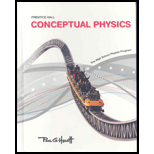
Concept explainers
How does a vector quantity differ from a scalar quantity?
To explain: The difference between the scalar and vector.
Explanation of Solution
Introduction:
Some physical quantities described by the only magnitude with specified units alone. For example, the bag contains 10 marbles. The mass of each marble is 2 gm. So the total mass of the bag as whole system is the numerical sum of the masses of 10 marble. So the mass of bag is
But in order to make complete description of the certain physical quantity it requires magnitude as well as direction. For example, displacement of particle in space, particle A with displacement along positive x-direction is 4 m and displacement 5 m along negative x-direction after certain time. So resultant displacement of particle A is,
Physical quantity which has both direction as well as magnitude, are called as vector quantities. Examples of vector quantities are velocity, force, electric field, linear momentum, etc. The addition, subtraction of the vectors can be made by triangle of vector addition. On other side the physical quantity which has only magnitude and not direction, are called as scalar quantity. Examples of scalar quantities are speed, mass, temperature, length. Addition subtraction of the scalar quantities made with simple arithmetic addition. Vector quantities represented by the putting an arrow over the symbol of physical quantity representing them for example
Conclusion:
Scalars quantities are the quantity whose description can be given by only through the magnitude whereas vectors are the quantity which can be described by the magnitude as well as direction.
Want to see more full solutions like this?
Chapter 5 Solutions
Conceptual Physics: The High School Physics Program
Additional Science Textbook Solutions
College Physics: A Strategic Approach (3rd Edition)
Conceptual Physical Science (6th Edition)
Applied Physics (11th Edition)
University Physics Volume 2
The Cosmic Perspective
University Physics (14th Edition)
 College PhysicsPhysicsISBN:9781305952300Author:Raymond A. Serway, Chris VuillePublisher:Cengage Learning
College PhysicsPhysicsISBN:9781305952300Author:Raymond A. Serway, Chris VuillePublisher:Cengage Learning University Physics (14th Edition)PhysicsISBN:9780133969290Author:Hugh D. Young, Roger A. FreedmanPublisher:PEARSON
University Physics (14th Edition)PhysicsISBN:9780133969290Author:Hugh D. Young, Roger A. FreedmanPublisher:PEARSON Introduction To Quantum MechanicsPhysicsISBN:9781107189638Author:Griffiths, David J., Schroeter, Darrell F.Publisher:Cambridge University Press
Introduction To Quantum MechanicsPhysicsISBN:9781107189638Author:Griffiths, David J., Schroeter, Darrell F.Publisher:Cambridge University Press Physics for Scientists and EngineersPhysicsISBN:9781337553278Author:Raymond A. Serway, John W. JewettPublisher:Cengage Learning
Physics for Scientists and EngineersPhysicsISBN:9781337553278Author:Raymond A. Serway, John W. JewettPublisher:Cengage Learning Lecture- Tutorials for Introductory AstronomyPhysicsISBN:9780321820464Author:Edward E. Prather, Tim P. Slater, Jeff P. Adams, Gina BrissendenPublisher:Addison-Wesley
Lecture- Tutorials for Introductory AstronomyPhysicsISBN:9780321820464Author:Edward E. Prather, Tim P. Slater, Jeff P. Adams, Gina BrissendenPublisher:Addison-Wesley College Physics: A Strategic Approach (4th Editio...PhysicsISBN:9780134609034Author:Randall D. Knight (Professor Emeritus), Brian Jones, Stuart FieldPublisher:PEARSON
College Physics: A Strategic Approach (4th Editio...PhysicsISBN:9780134609034Author:Randall D. Knight (Professor Emeritus), Brian Jones, Stuart FieldPublisher:PEARSON





